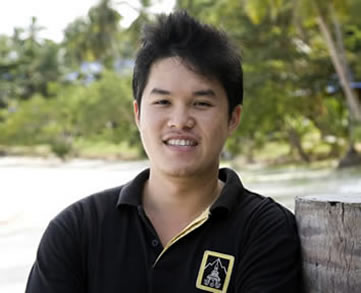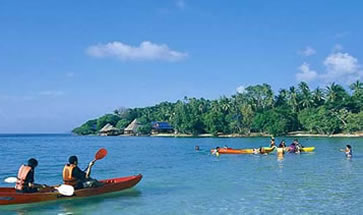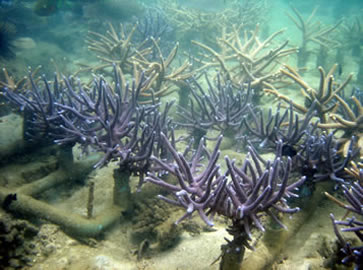KOH TALU ISLAND RESORT
| TRAVEL WITH A CONSCIENCE

KOH TALU ISLAND RESORT, BAN SAPHAN, THAILAND
The last unspoilt island in Thailand offers not only the ultimate in relaxation, but an inspiring story to go with it. Bridget McNulty tells the tale.
 We support the coral preservation and coral creation projects at Koh Talu. It shows clearly what gritty determination and dedication can achieve.
We support the coral preservation and coral creation projects at Koh Talu. It shows clearly what gritty determination and dedication can achieve.
Book a trip to Koh Talu and you too can help preserve this slice of paradise by taking part in the coral restoration process yourself.
Text Bridget McNulty
Photography Mark Peddle, and courtesy Koh Talu Resort
Published 20th October 2009
It’s a picture postcard come to life: powdery white sand that stretches as far as the eye can see, crystal clear turquoise water lapping the shore, shells scattered along the tide line and a fringe of palm trees leading to a low swell of forested mountains that rise to a bright blue sky filled with puffy white clouds. It’s so beautiful it could be Photoshopped. But what makes Koh Talu Island remarkable is not, in fact, what you can see with the naked eye, but what lies unseen below the surface of the ocean: the coral.
It might be hard to believe, but this coral, this island, this last remaining stretch of paradise in Thailand is all thanks to one family.
Let’s rewind a few decades. Back to the 80s, when Preeda Charoenpak is a fisherman with a fleet of ten fishing boats operating in the Gulf of Thailand. One day in monsoon season, Preeda is out fishing in his boat, Sarika, when he happens across a giant shoal of fish, more than he can count. He shouts to his friend to come and reel in the catch with him; within minutes he is surrounded by more than twenty boats, and the entire shoal of fish is wiped out in less than half an hour. This gets Preeda thinking. If they continue fishing the oceans like this, soon there will be nothing left to fish.
So he decides to change his life and, in the process, stops to pay his respects to a revered monk in Ban Saphan, the small town across the bay from Koh Talu Island. It is while he is in Ban Saphan that he drives down a dirt road and finds a very beautiful house – a house that he will later christen Sarika Resort (after his boat) and open as Ban Saphan Bay’s first hotel.
Fast forward ten years and Preeda is itchy for a new challenge, so he sells the hotel and starts the first shrimp hatchery in the area – studying the intricacies of the new business and growing his hatcheries from two to four, four to eight, and so on, and so on. Soon he is exporting shrimp overseas, one of the first successful shrimp exporting operations in Thailand. At the same time, Preeda has been working in the area (for six or seven years) on a project to stop big fishing companies from pillaging the ocean. In the centre of the protected area lies Koh Talu, a treasure island with a coconut farm owned by four families. These families are on the brink of selling the coconut farm to a large company in Bangkok, who want to develop the area and have no interest in the fishing project’s goals and ambitions. But Preeda Charoenpak is having none of it. He steps in at the last minute and buys the coconut farm on the island so that the project can continue, then hands it over to his eldest son to manage. He builds eleven simple bungalows on the beach, and they are used mainly to house friends on holiday.
It wasn’t just friends who came to visit the island on holiday, though. It was also Paopipat Charoenpak, Preeda’s youngest son (known to everyone as Mr. Pow) and an enterprising thinker, even in high school. Mr Pow tells of how he would visit his brother during the school holidays and help out on the island. “After three years, though, the money was empty. As it always is in families, there was conflict between my father and my brother. They both had different ideas, they weren’t speaking the same language.” That’s where Pow came in, negotiating between family members, trying to find a middle ground so that they could agree on what to do with the island. When he returned to school after the holidays, he dug up an old feasibility report that had been done on the island many years back and adapted it to suit the current situation, then approached the bank for a loan. “I asked for 12 million baht (about US$358 000) but they only gave me 3 million, because I was 17 years old,” he says matter-of-factly, unaware of how extraordinary it is for a 17 year old to be thinking of anything other than homework, school and girls.
“It was my idea, but it’s been my dad’s life to make this project happen, for the last thirty years, so I’m really just building on that. I obviously can’t do everything by myself. We have a good understanding now, we all work together. My big brother is in charge of operations, my sister works with me in the office, and my dad gives us advice whenever we need it. It’s all about good co-ordination and communication.” And it’s a formula that seems to have worked – after three years Pow was able to pay back his loan in full. The initial building was the Pearl Bay segment of the hotel, and since then they’ve built the main section, xxx, along with a large wooden restaurant on stilts, a pier and a beach bar.
It’s all about good family relations,” Pow explains. “If we can do it well, it’s easier for others to join. We want to create a model that’s simple to follow, raise some awareness about what’s happening, and be an example for everyone.” Pow believes in having good relationships with everyone he works with, from the Tourist Board to the surrounding resorts, the governor of the area and the locals. They’re all involved in the good work being done here.
So what is this good work? In a word, coral. Before Pow and his family came along, the coral reefs in the area were severely damaged. Large fishing boats, tourists and monsoon currents had destroyed vast sections of the coral, and other sections were completely covered by sand and choked by seaweed, unable to grow. Pow and his brothers saw it while out snorkeling when they first came to the island, and decided to do something about it. What they discovered was that if hard coral is put in its optimum location it will flourish. Together with a few colleagues, including a teacher and researcher at the local high school, Mr. Prasarn Sangpiboon, Pow researched how to transplant coral. It was a project that many were interested in helping him with, not only for nature conservation reasons, but to assist in the tourism of the area (snorkeling has become a major drawcard now that the coral is replenished). That was 10 years ago, but as Pow says, “Five years is not too many in coral, it only grows 10 to 14cm a year.”
What strikes me, as I listen to Pow talk about the coral project, is not only his obvious enthusiasm for the work, but his thorough and ongoing research into the matter. So many people plunge headfirst into good causes without thinking things through, but Pow is well aware of every facet of this project, from the major to the minor. Perhaps it’s his degree in Tourism Management that stands him in good stead; perhaps it’s the genes he inherited from his father.
“We use nature as much as possible,” Pow explains. “But sensibly. Sometimes we need help from outside – especially with the coral. What we discovered was that if we start coral hatcheries on PVC bases, after a while the coral is strong enough to be removed from the PVC base and we can leave it growing out of the smallest section of the grid. As it grows, it starts eating into that last piece of PVC, and because the PVC is non-toxic, it doesn’t harm the ocean.” Pow and his colleagues have used this method to ‘plant’ more than 80 000 corals in 5 different locations, a major achievement for a project just out of its infancy.
This thread of using nature and good sense to achieve great things is present throughout Pow’s business. “We’re very careful here on the island, not to do any damage. When coconuts drop to the ground in the coconut farm, we let them lie there, or plant them, so that we can create a jungle that guards against soil erosion. We didn’t build a big water tank when we opened the hotel, we used a reservoir that was already in the centre of the island, and just made it bigger. We want to work together with nature.” It’s not just land, as Pow sees it. “We don’t want to sell the island, we don’t want to get greedy and over-develop it. We need to think long-term, not just think about making money now.”
It might be hard to believe, but this coral, this island, this last remaining stretch of paradise in Thailand is all thanks to one family.
Let’s rewind a few decades. Back to the 80s, when Preeda Charoenpak is a fisherman with a fleet of ten fishing boats operating in the Gulf of Thailand. One day in monsoon season, Preeda is out fishing in his boat, Sarika, when he happens across a giant shoal of fish, more than he can count. He shouts to his friend to come and reel in the catch with him; within minutes he is surrounded by more than twenty boats, and the entire shoal of fish is wiped out in less than half an hour. This gets Preeda thinking. If they continue fishing the oceans like this, soon there will be nothing left to fish.
So he decides to change his life and, in the process, stops to pay his respects to a revered monk in Ban Saphan, the small town across the bay from Koh Talu Island. It is while he is in Ban Saphan that he drives down a dirt road and finds a very beautiful house – a house that he will later christen Sarika Resort (after his boat) and open as Ban Saphan Bay’s first hotel.
Fast forward ten years and Preeda is itchy for a new challenge, so he sells the hotel and starts the first shrimp hatchery in the area – studying the intricacies of the new business and growing his hatcheries from two to four, four to eight, and so on, and so on. Soon he is exporting shrimp overseas, one of the first successful shrimp exporting operations in Thailand. At the same time, Preeda has been working in the area (for six or seven years) on a project to stop big fishing companies from pillaging the ocean. In the centre of the protected area lies Koh Talu, a treasure island with a coconut farm owned by four families. These families are on the brink of selling the coconut farm to a large company in Bangkok, who want to develop the area and have no interest in the fishing project’s goals and ambitions. But Preeda Charoenpak is having none of it. He steps in at the last minute and buys the coconut farm on the island so that the project can continue, then hands it over to his eldest son to manage. He builds eleven simple bungalows on the beach, and they are used mainly to house friends on holiday.
It wasn’t just friends who came to visit the island on holiday, though. It was also Paopipat Charoenpak, Preeda’s youngest son (known to everyone as Mr. Pow) and an enterprising thinker, even in high school. Mr Pow tells of how he would visit his brother during the school holidays and help out on the island. “After three years, though, the money was empty. As it always is in families, there was conflict between my father and my brother. They both had different ideas, they weren’t speaking the same language.” That’s where Pow came in, negotiating between family members, trying to find a middle ground so that they could agree on what to do with the island. When he returned to school after the holidays, he dug up an old feasibility report that had been done on the island many years back and adapted it to suit the current situation, then approached the bank for a loan. “I asked for 12 million baht (about US$358 000) but they only gave me 3 million, because I was 17 years old,” he says matter-of-factly, unaware of how extraordinary it is for a 17 year old to be thinking of anything other than homework, school and girls.
“It was my idea, but it’s been my dad’s life to make this project happen, for the last thirty years, so I’m really just building on that. I obviously can’t do everything by myself. We have a good understanding now, we all work together. My big brother is in charge of operations, my sister works with me in the office, and my dad gives us advice whenever we need it. It’s all about good co-ordination and communication.” And it’s a formula that seems to have worked – after three years Pow was able to pay back his loan in full. The initial building was the Pearl Bay segment of the hotel, and since then they’ve built the main section, xxx, along with a large wooden restaurant on stilts, a pier and a beach bar.
It’s all about good family relations,” Pow explains. “If we can do it well, it’s easier for others to join. We want to create a model that’s simple to follow, raise some awareness about what’s happening, and be an example for everyone.” Pow believes in having good relationships with everyone he works with, from the Tourist Board to the surrounding resorts, the governor of the area and the locals. They’re all involved in the good work being done here.
So what is this good work? In a word, coral. Before Pow and his family came along, the coral reefs in the area were severely damaged. Large fishing boats, tourists and monsoon currents had destroyed vast sections of the coral, and other sections were completely covered by sand and choked by seaweed, unable to grow. Pow and his brothers saw it while out snorkeling when they first came to the island, and decided to do something about it. What they discovered was that if hard coral is put in its optimum location it will flourish. Together with a few colleagues, including a teacher and researcher at the local high school, Mr. Prasarn Sangpiboon, Pow researched how to transplant coral. It was a project that many were interested in helping him with, not only for nature conservation reasons, but to assist in the tourism of the area (snorkeling has become a major drawcard now that the coral is replenished). That was 10 years ago, but as Pow says, “Five years is not too many in coral, it only grows 10 to 14cm a year.”
What strikes me, as I listen to Pow talk about the coral project, is not only his obvious enthusiasm for the work, but his thorough and ongoing research into the matter. So many people plunge headfirst into good causes without thinking things through, but Pow is well aware of every facet of this project, from the major to the minor. Perhaps it’s his degree in Tourism Management that stands him in good stead; perhaps it’s the genes he inherited from his father.
“We use nature as much as possible,” Pow explains. “But sensibly. Sometimes we need help from outside – especially with the coral. What we discovered was that if we start coral hatcheries on PVC bases, after a while the coral is strong enough to be removed from the PVC base and we can leave it growing out of the smallest section of the grid. As it grows, it starts eating into that last piece of PVC, and because the PVC is non-toxic, it doesn’t harm the ocean.” Pow and his colleagues have used this method to ‘plant’ more than 80 000 corals in 5 different locations, a major achievement for a project just out of its infancy.
This thread of using nature and good sense to achieve great things is present throughout Pow’s business. “We’re very careful here on the island, not to do any damage. When coconuts drop to the ground in the coconut farm, we let them lie there, or plant them, so that we can create a jungle that guards against soil erosion. We didn’t build a big water tank when we opened the hotel, we used a reservoir that was already in the centre of the island, and just made it bigger. We want to work together with nature.” It’s not just land, as Pow sees it. “We don’t want to sell the island, we don’t want to get greedy and over-develop it. We need to think long-term, not just think about making money now.”





It seems that Mr. Pow will stop at nothing to get others involved in conserving this stunning stretch of ocean. He’s been in meetings with government officials from the Marine Resources and Coastal Department, and they’re looking at reducing fishing in the area so that it can be properly zoned for the preservation of the coral. It’s an area for tourism, as he sees it, so everyone will benefit from the conservation measures he’s trying to put in place – people already have (ten years ago snorkeling was not at the top of anybody’s To Do List in the area).
“The idea is that if we work together, we can have more,” Pow explains earnestly. “We start with our family, and make sure we have good relations with each other. Then we move outwards, to our community, and the communities surrounding us. We make a system of how to share public resources. And we use the power of everyone on the island. We all work together.”
It’s an inspiring message, and one that could no doubt be repeated on other islands, if it’s not too late. What has been done on Koh Talu – a small resort with wooden Thai-style houses on stilts, a thatched bar and restaurant, and that blue blue ocean filled with all kinds of extraordinary coral – all started with one family. But that one family is determined to spread the message of how they did it, and why, to anyone who is willing to listen.
So do yourself a favour. Take a few days out of life as you know it and make your way to Koh Talu Island. Not only is it as close to paradise as you’ll find in Thailand, it’s the kind of place that will inspire and motivate you to be the change you wish to see in the world.
“The idea is that if we work together, we can have more,” Pow explains earnestly. “We start with our family, and make sure we have good relations with each other. Then we move outwards, to our community, and the communities surrounding us. We make a system of how to share public resources. And we use the power of everyone on the island. We all work together.”
It’s an inspiring message, and one that could no doubt be repeated on other islands, if it’s not too late. What has been done on Koh Talu – a small resort with wooden Thai-style houses on stilts, a thatched bar and restaurant, and that blue blue ocean filled with all kinds of extraordinary coral – all started with one family. But that one family is determined to spread the message of how they did it, and why, to anyone who is willing to listen.
So do yourself a favour. Take a few days out of life as you know it and make your way to Koh Talu Island. Not only is it as close to paradise as you’ll find in Thailand, it’s the kind of place that will inspire and motivate you to be the change you wish to see in the world.
KOH TALU ISLAND RESORT, BAN SAPHAN, THAILAND
Style Simple beachside bungalows. Don’t expect five star accommodation – that’s not the emphasis here. The rooms are spacious and comfortable, though, with large-screen TV (only Thai channels), fridge, aircon and enormous bathroom.
Setting Paradise. Step out onto your deck and you’re faced with an endless vista of turquoise ocean and white beach. Spend your days snorkeling, swimming, suntanning, kayaking or hanging out at the beach bar.
Why you'll love it It is just so beautiful, and completely unspoilt. It’s the kind of island Thailand used to be famous for, before they all became over-run with tourists and touts.
Good to know The speedboat to the island leaves from a specific launch in Ban Saphan (about a twenty minute drive from Ban Krut) at specific times each day. Call or email ahead to arrange a pick-up. Once on the island, all meals are included, alcoholic beverages are not.
What they’re doing for the community Replenishing the ocean with coral, which in turn increases tourism revenue in the area, as tourist boats arrive each day for snorkeling trips (in specially demarcated areas). They also run a sustainable fishing project that is working on putting rules in place to make the fishing in the area more conservation-conscious.
What you can do to help Visit Koh Talu, snorkel in the coral, and carry the message back to everyone you know so that projects of this kind can spread to different areas of the world. Occasionally the resort runs coral planting weekends – enquire on the website.
Room for improvement The food is not great. The ingredients are all fresh and tasty, but the combinations lack imagination and are a little dull. Hiring a consulting chef to put together a new menu would make a world of difference.
Rates Depending on the season, from 495 to 995 Thai Baht per night (about US$15 to US$20 per night), excluding food.
Address111/1 Moo 10, Tumbol Bangsaphan, Bangsaphan Noi, Prachuap khiri khan Province 77170 Thailand
Tel +66 32 442 636
Fax +66 32 442 637
How to Get There Fly into Bangkok International Airport, and then take a 4 hour train (2nd class is air-conditioned and comfortable) to Ban Krut. Koh Talu Resort will arrange a pick-up to take you from Ban Krut to the speedboat, and from there it’s an easy 20 minute trip to the island.
THE CORAL
PROJECT





©Copyright 2006 - 2019 JUST THE PLANET LUXURY TRAVEL CC - All rights reserved







 Tweet
Tweet